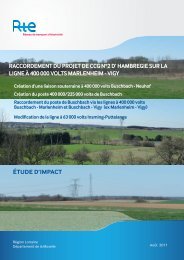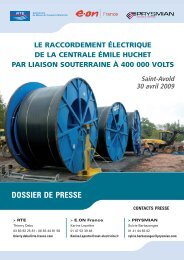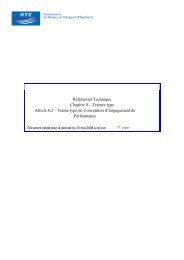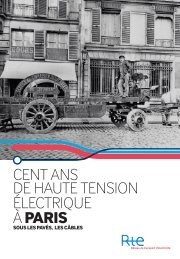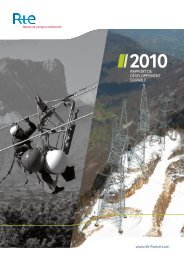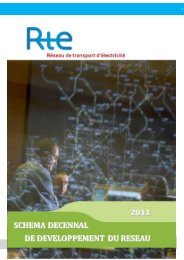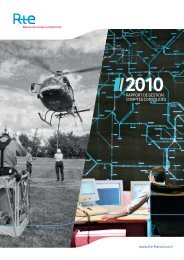Power System Reliability Report - RTE
Power System Reliability Report - RTE
Power System Reliability Report - RTE
- No tags were found...
Create successful ePaper yourself
Turn your PDF publications into a flip-book with our unique Google optimized e-Paper software.
R-AUDIT-SG-DAR-MAS-11-2011/022010 <strong>Reliability</strong> <strong>Report</strong>Page : 19/408 juillet 2011in July and 33.6 % in March. The maximum production level varied over the months between 2400and 4200 MW. During the year, the distribution of produced power shows a first decile at 333 MW anda ninth decile at 2178 MW. Though there is high variability throughout the year, the annualperformances are stable.The number of photovoltaic generation units has grown considerably, with roughly 800 MW installedat the end of the year.For thermal units, we have logged the industrial commissioning of three 440 MW gas combined cycleunits (GCC) connected in 2009 (2 in the East and one at Fos), confirming that the expectedperformances for these units have been checked and contracted with the producers. A GCC wasconnected at Grande-Rivière, near Montoir-de-Bretagne, which will help to control the voltageproblems in the West. Finally two 180 MW peak power units (combustion turbines) werecommissioned at Montereau.Risk of multiple trippings at close intervalsIn the past, different cases of simultaneous or very close trippings of several generating sets (e.g.:February 2009), particularly nuclear, for a same reason usually linked to problems with cooling waterintake (waste in the river following a storm, floods, tide flows, etc.) resulted in serious problems forthe electrical system (ESS level B or C). Feedback on these incidents, as concerns the interfacebetween the producer and <strong>RTE</strong>, mainly focused on reinforcing the warning systems. The existingsystem worked well in 2010 and was built up in the Rhône Valley with the commissioning of a warningsystem, feeding through to <strong>RTE</strong> and jointly coordinated by EDF and CNR.Voltage return testsAn important point to consider for nuclear reactors is thesuccess rate of plant islanding, given their importance whencoping with a possible network restoration following a majorincident. Performance levels remain extremely satisfactory:10 out of the 11 scheduled islanding operations weresuccessful and there were 2 unscheduled but successfuloperations.The other major point in the event of a large scale incidentconcerns the voltage return scenarios that constitute anadditional source of independent means for power plants to supply the auxiliary systems of nuclearreactors; they can also be useful for network restoration. The contract signed with EDF on this subjectplans annual tests on each site and the testing of each scenario once every 3 years. In 2010, 19 outof 26 initially scheduled tests were carried out, 16 successfully (in 2009, 16 out of 23 initiallyscheduled tests, all successful). One of the three failed tests corresponds to the first test of a scenariothat was changed following developments in the network. The two others gave rise to ESS level A,one of which is <strong>RTE</strong>‟s responsibility (return accomplished but not in the given time limit).In terms of the ability to achieve these returns during a large scale incident, the 84% success rate forthe attempted tests is similar to past years (100, 83, 79, and 95% from 2009 to 2006). However, thedifficulty in reaching a level very close to 100% every year shows that achieving the return of thesesub-networks is not insignificant: these tests contribute to the technical verification of restorationprocedures and to regular training of the different EDF and <strong>RTE</strong> teams involved.The ratio between successful tests and those initially scheduled is also similar to previous years(62 %). Hence, the objective/result gap remains stable: 4 untested sites, like in 2009 and 8 delayedtriennial test scenarios (9 in 2009).4.1.2 Protection systems, operation PLCs, instrumentation and controlA complex PLC system is being set up in the southern part of the network to cope with a simultaneoustripping of two double lines on a major link, which could cause a critical stability incident in certainconfigurations. The PLC acts in approximately a hundredth of a millisecond to trigger productiontripping in the Rhône Valley. Its creation requires special attention to ensure its operating reliability; itapplies the principles decreed in the design and maintenance directive published in 2009 relative toCopyright <strong>RTE</strong>. This document is the property of <strong>RTE</strong>. Any communication, reproduction, publication even partial is forbidden without the express written authorisationElectricity Transmission <strong>System</strong> operator (<strong>RTE</strong>)




